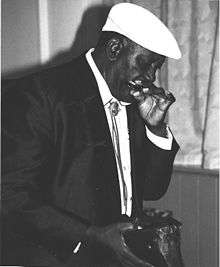Snooky Pryor
James Edward "Snooky" Pryor (September 15, 1919[2] or 1921[3] – October 18, 2006) was an American Chicago blues harmonica player.[1][4] He claimed to have pioneered the now-common method of playing amplified harmonica by cupping a small microphone in his hands along with the harmonica, although on his earliest records, in the late 1940s, he did not use this method.
Snooky Pryor | |
|---|---|
 Pryor in Edinburgh, June 1993 | |
| Background information | |
| Birth name | James Edward Pryor |
| Born | September 15, 1919 or 1921 Lambert, Mississippi, United States |
| Died | October 18, 2006 (aged 85-87) Cape Girardeau, Missouri, United States |
| Genres | Chicago blues,[1] Delta blues |
| Occupation(s) | Musician, carpenter |
| Instruments | Vocals, blues harp, bugle |
| Years active | 1945–2006 |
| Labels | Vee-Jay, Virgin, ABC, Blind Pig, Telarc, Electro-Fi |
| Associated acts | Floyd Jones, Moody Jones, Sunnyland Slim, Eddie Taylor, Johnny "Man" Young, Leroy Foster (musician), Homesick James |
Career
Pryor was born in Lambert, Mississippi, United States.[3] He developed a country blues style influenced by Sonny Boy Williamson I (John Lee Williamson) and Sonny Boy Williamson II (Aleck Ford "Rice" Miller). In the mid-1930s, in and around Vance, Mississippi, Pryor played in impromptu gatherings of three or four harmonica players, including Jimmy Rogers, who then lived nearby and had yet to take up playing the guitar.[5] Pryor moved to Chicago around 1940.
While serving in the U.S. Army he would blow bugle calls through a PA system, which led him to experiment with playing the harmonica that way. Upon discharge from the Army in 1945, he obtained his own amplifier and began playing harmonica at the outdoor Maxwell Street Market, becoming a regular on the Chicago blues scene.
Pryor recorded some of the first post-war Chicago blues in 1948,[1] including "Telephone Blues" and "Snooky & Moody's Boogie", with the guitarist Moody Jones, and "Stockyard Blues" and "Keep What You Got", with the singer and guitarist Floyd Jones.[3] "Snooky & Moody's Boogie" is of considerable historical significance: Pryor claimed that the harmonica virtuoso Little Walter directly copied the signature riff of Pryor's song in the opening eight bars of his blues harmonica instrumental "Juke," an R&B hit in 1952.[6] During the 1950s, Pryor regularly toured in the South.[3] In 1967, Pryor moved to Ullin, Illinois. He quit music and worked as a carpenter in the late 1960s but was persuaded to make a comeback.[7] Blues fans later revived interest in his music, and he resumed recording occasionally until his death in nearby Cape Girardeau, Missouri, at the age of 85.
In January 1973 he performed alongside Homesick James with the American Blues Legends tour, which played throughout Europe. On this tour they recorded an album in London, Homesick James & Snooky Pryor, for Jim Simpson's label, Big Bear Records.
Some of his better-known songs are "Judgement Day" (1956), "Crazy 'Bout My Baby" (from Snooky, 1989), "Where Did You Learn to Shake It Like That" (from Tenth Anniversary Anthology, 1989), and "Shake My Hand" (1999).
Pryor's son Richard "Rip Lee" Pryor is also a blues musician and performs in and around his hometown of Carbondale, Illinois.
Discography
Singles
Albums
- Snooky Pryor (1970), Flyright Records FLY 100, made in England
- Homesick James & Snooky Pryor (1973), Virgin Records, London
- Do It If You Want To (1973), ABC Records, Los Angeles, New York
- Snooky (1989), Blind Pig Records
- Snooky Pryor (1991), Paula Records
- Johnny Shines and Snooky Pryor: Back to the Country (1991), Blind Pig Records
- Snooky Pryor: Too Cool to Move (1992), Antone's Records[8]
- In This Mess Up to My Chest (1994), Antone's Records
- Mind Your Own Business (1996), Antone's Records
- Snooky Pryor: Shake My Hand (1999), Blind Pig Records
- Double Shot!, Snooky Pryor and Mel Brown (2000), Electro-Fi Records
- Super Harps II, with Carey Bell, Lazy Lester, Raful Neal (2001), Telarc Records
- Snooky Pryor and His Mississippi Wrecking Crew (2002), Electro-Fi Records
- Mojo Ramble (2003), Electro-Fi Records
See also
- Chicago Blues Festival
- List of Chicago blues musicians
- List of harmonica blues musicians
- San Francisco Blues Festival
References
- Du Noyer, Paul (2003). The Illustrated Encyclopedia of Music. Fulham, London: Flame Tree Publishing. p. 181. ISBN 1-904041-96-5.
- Eagle, Bob; LeBlanc, Eric S. (2013). Blues: A Regional Experience. Santa Barbara, California: Praeger. p. 193. ISBN 978-0313344237.
- Colin Larkin, ed. (1997). The Virgin Encyclopedia of Popular Music (Concise ed.). Virgin Books. p. 981. ISBN 1-85227-745-9.
- Russell, Tony (10 November 2006). "Obituary of Snooky Pryor". The Guardian. Retrieved 7 August 2011.
- Robert Palmer. Deep Blues. Penguin Books. p. 199. ISBN 978-0-14-006223-6.
- "I Started the Big Noise Around Chicago". Interview with Snooky Pryor conducted by Jim O'Neal, Steve Wisner, and David Nelson. Living Blues, no. 123 (Sept.–Oct. 1995), pp. 10–11.
- Russell, Tony (1997). The Blues: From Robert Johnson to Robert Cray. Dubai: Carlton Books. p. 157. ISBN 1-85868-255-X.
- Record label founded in 1987 by Clifford Antone, owner of Antone's Nightclub, in Austin, Texas, to release live recordings of performances at the club; Profile of Antone's Records. Discogs.com. Retrieved 2015-07-27.
External links
- Biography. AllMusic.
- Pryor Biography. Blind Pig Records.
- Pryor bio. Hohner Harmonica Company, which has a Pryor sound clip (mp3 format).
- Obituary. The Guardian. Accessed December 1, 2006.
- Obituary. KLBC radio. Accessed December 1, 2006.
- Pryor Discography. Accessed December 19, 2007.
- Snooky Pryor with Mel Brown and the Homewreckers - "Headed South" on YouTube
- Interview on Canoe, July 2000. Accessed December 1, 2006.